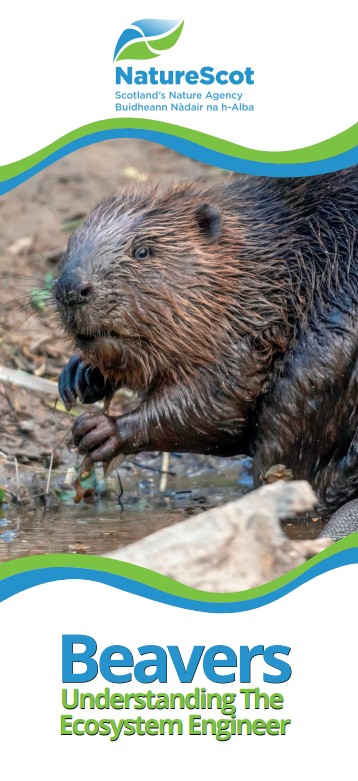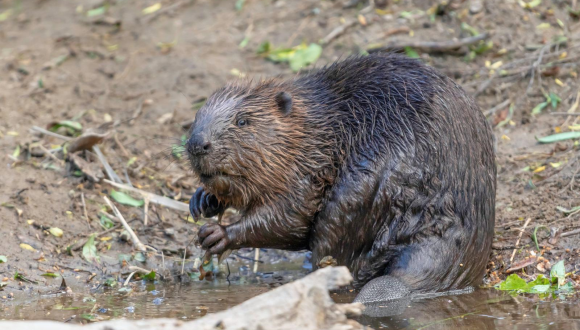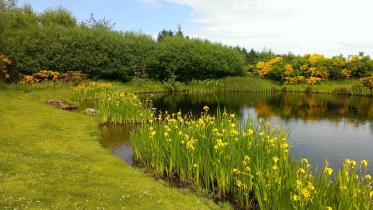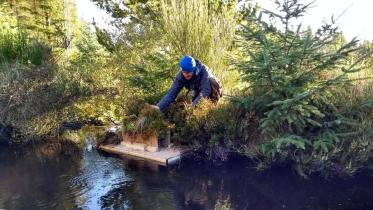Beavers: Understanding the Ecosystem Engineer leaflet

Published: 2023
What is a beaver?
The Eurasian beaver is a large, semiaquatic, herbivorous rodent which is native to Scotland. It is found in freshwater environments such as rivers, streams and lochs, and lives in family groups typically of 2 to 5 animals which will contain a mated pair and any offspring from that year and the year before.
They were hunted to extinction in Scotland roughly 400 years ago for their fur, meat and scent glands but have been reintroduced to Scotland. The population is now estimated to be greater than 1,000 animals.
Beavers are known as a keystone species due to their ability to shape freshwater habitats which benefits many other animal and plant species, but their engineering can conflict with human infrastructure and farming systems.
Beaver foraging
Beavers are herbivores and browse on a wide range of bark, shoots, leaves and roots, from riparian to aquatic vegetation. They fell trees for food but also building materials for constructing their dams and lodges.
Beavers mostly feed close to the water’s edge to avoid predation. As a result most foraging activity occurs within 20m or so of the water’s edge, with beavers rarely moving more than 60m from water to forage.
Foraging by beavers opens up woodland canopy, allowing more light to reach the ground, increasing the diversity of plant, lichen and bryophyte species and improving foraging opportunities for birds and bats. It also increases the amount of deadwood on land and in water, providing valuable cover from predation for a range of species. Deadwood also provides habitat for invertebrates, which act as a food source for amphibians, birds and fish.
Tree felling can be undesirable and hazardous in some locations. Sensitive trees in the immediate riparian zone may require mitigation to prevent them from being felled. They can be protected individually using wrapping and painting methods or as a stand using fencing.
Beaver damming
Beavers build dams to increase and maintain the water depth in their territory to protect them from predation as they navigate it, to open up new areas for browsing, and to keep the entrances to their multiple burrows or lodges submerged.
In freshwater habitats, with wide water courses and/or where water depth is naturally sufficient such as the main channel of a river or a loch, beavers will physically not be able to build a dam.
The creation of wetland behind a dam provides new habitat for a diverse range of plant and invertebrate species. This in turn provides opportunities for a range of birds, bats, mammals and amphibians.
By impounding water and slowly releasing it beaver dams reduce the risk of flooding downstream, drought and may even prevent the spread of wildfire.
Beaver damming can cause localised flooding problems for people. for example flooding of crops, or potentially affecting the character of the watercourse for fish.
Consideration can be given to dam removal or mitigation under licence from NatureScot. Works need to consider animal welfare and be carried out without causing pollution.
Beaver lodges and burrows
Lodges and burrows both provide a safe space where beavers can rest and breed protected from water and predators. Theses structures are also protected under legislation and cannot be disturbed without a licence.
Most beavers have a mixture of burrows and bank lodges in their territory, with a bank lodge built around a chamber of burrows with a visible cap on top.
Beaver lodges have been found to provide nesting and resting opportunities for a variety of bird species and lodges and burrows have also been found to be used by mice, shews, water voles and even otters.
Burrowing by beavers can create weakness in flood banks, increasing erosion and resulting in more dynamic river systems. Burrows can occasionally be a health & safety risk as they can collapse damaging or flooding nearby property or machinery.
Any land manager experiencing an issue from burrowing activity should contact NatureScot for advice on mitigation and species licensing.
Common questions
Do beavers carry disease?
Like all native mammals, beavers can carry a range of pathogens and host-specific parasites. Long-term health monitoring of Scottish beavers has revealed they do not appear to be significant reservoirs of diseases and the risk of introducing significant disease to humans, domestic animals or wildlife from captive bred or wild beavers in Britain was low. Beavers undergo disease screening and health checks as part of the translocation process
What will control the beaver population?
People often believe beavers have no predators in Britain due the absence of the European wolf, European lynx and brown bear but young beavers, particularly kits, are predated by a number of species.
In Scotland territorial fights, infections from fight wounds and road traffic accidents are likely to the biggest cause of mortality to wild beavers. With the availability of suitable habitat defining and controlling the size of the population.
Do beavers prevent fish passage?
The impact beaver dams have on migrating fish is likely to be complex, site specific and change over time. Recent research in Scotland found that Brown trout benefited from the increased availability of suitable habitat and food source created by beaver damming activity.
Get support
If you own or manage land which is affected by beaver activity contact our beaver mitigation team for FREE advice by emailing [email protected].






